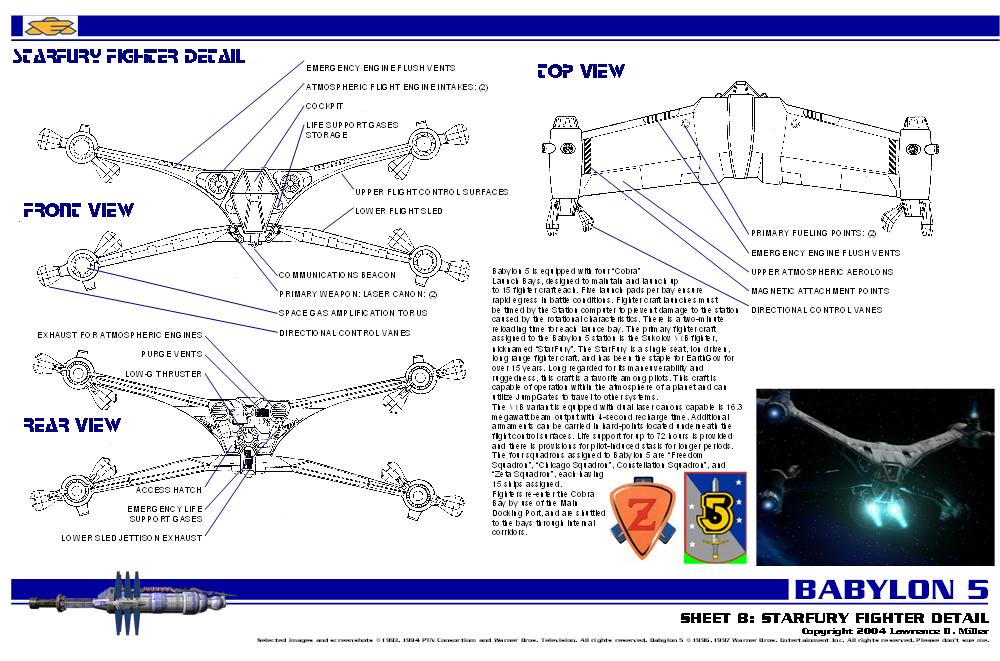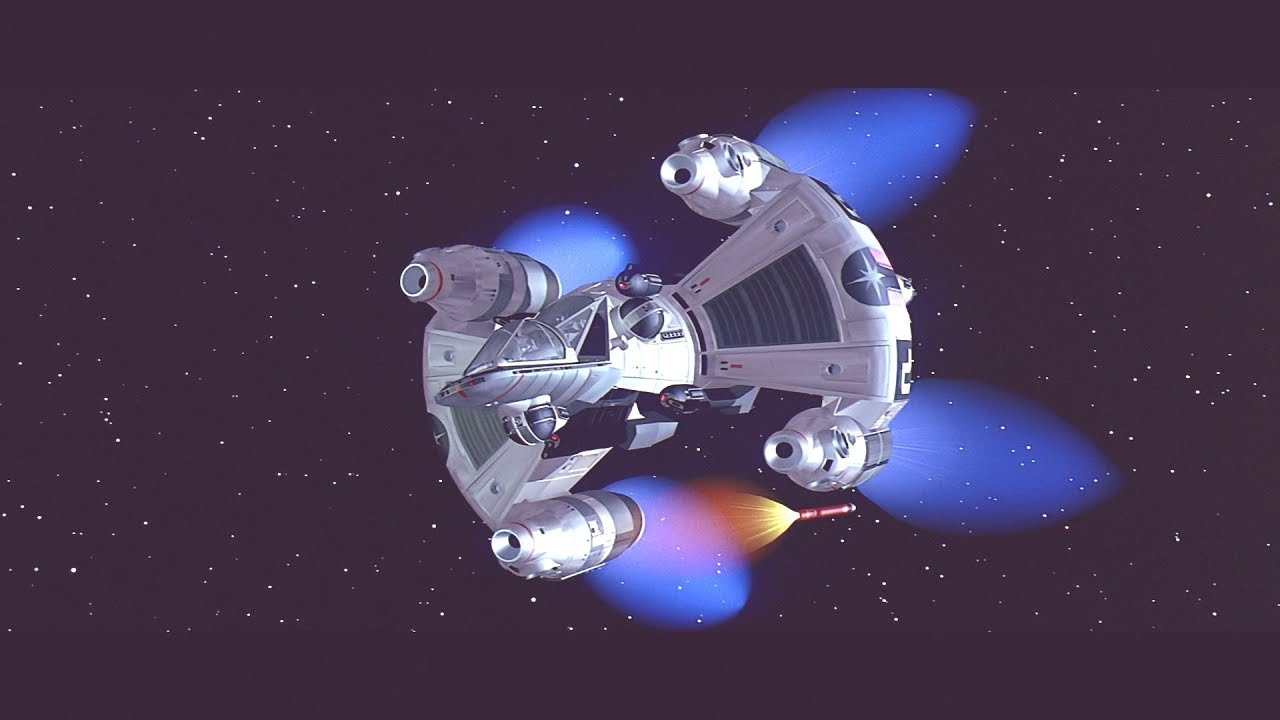I am on try 10 or so of my "first chapter" for my Sublight Universe Saga. (The one in the universe where people worked on nuclear power and rockets while our reality was perfecting automobiles and airplanes).
My opening takes place on a shuttle craft. Slight problem, I haven't designed a shuttlecraft yet. Now a casual writer would be happy to just take a few inspirations and slap something vaguely shuttle shaped together.
Shuttles seem to come in a few forms. In Star Trek, they are basically space minivans:

Others are starfighters. Instead of cargo, they carry a single occupant and weapons. Star Fury and a Gunstar:


Step one was to figure out was do I have a realistic scale for the ships. To do this I had to lay one out using a spreadsheet like the one I use for larger ships. Obviously I can simplify a few things, but they are still governed by the Tsiolkovsky rocket equation:
Some mass in propellent is still shot out of the ship at incredible speeds. And the combined drop in mass, and kinetic energy imparted, causes the ship to change speed. But for nuclear propulsion there is a cost. You need a reactor, and the system to channel the power produced by that reactor into propellant.
However there is a minimum size for a reactor. Or at least a reactor that produces a useful output. The compact fusion reactor project is trying to get one down to 10-20 tons. A 20 ton reactor is fine for something along the lines a ship sized craft. But anything smaller ends up being more reactor than payload.
But then I ran across this paper from Nasa. The concept is that instead of a reactor superheating propellant, you pack fusion fuel into metallic shells. The shells a minute amount of nuclear fuel surrounded by a reasonably dense but otherwise inert material. Compressing the pellets with lasers or intense magnetic fields causes a fusion reaction which vaporizes the entire pellet. And in the process, releasing a lot kinetic energy.
Essentially you just need an igniter and a rocket nozzle. The energy output by this system is mainly kinetic energy. You don't even need much of a heat management system. The fusion reaction is happening outside of the spacecraft. The "fuel" is basically millimeter sized spheres.
Fortunately, as a science fiction author, I don't have to really explain all of the details about how it works. I just need to provide enough of a hint that I know it does to convince the reader. In this case, our Rocket Equation still works. We just fudge in different numbers. I also have to explain what is powering the igniter, and figure out if these craft are possibly like jet aircraft (or naval gas turbines) that need an external starter to get them going.
Fun fact: Navy ships that use gas turbines actually have to keep tanks to compressed air on board. To start the engines, they release the air from the tanks into the fan blades to get them started. Large cargo ships with marine diesels also start their engines with compressed air. And there is only enough air in the tanks for a finite number of starts.
Let us imagine that our shuttle/fighter platform is something that is so mass produced it is essentially ubiquitous. I'm picturing a Single Stage to Orbit equivilent to the DC3 or the 737. We'll say the ships are built by Etoyoc Heavy Industries. And their most popular model is one that can go from the Earth to the surface of the moon in a single stage. This requires a DeltaV of 15910 m/s, and a thrust to weight ratio greater than 1.0.
The solution to this problem would be applicable in every other potential cargo market in the Solar System. Overcoming Earth's gravity could be replaced by either hauling a lot more cargo, or taking that cargo to a higher speed. And while you could design a cargo/passenger/light warship platform optimized for different regions of the solar system, you would lose in the areas that really matter: operating costs.
Having one platform that can do everything (albeit half assed) means that you only have to keep one type of fuel in stock, your mechanics need only be trained on one set of technologies, and your pilots (the really expensive to train) can work across your entire fleet.
Like jet aircraft, electrical power can be generated using an Auxiliary Power Unit (APU), which is just a miniature engine that spins a generator when the main engines are not operating.
Despite surmounting the reactor issue, we still have the problem of life support equipment. Any journey more than a few hours can't be done in a space suit alone. You need some sort of shirt-sleeve environment for your crew. Basic orbital maneuvers on Earth are hours long, and transits to the moon take days. So the vessel will need a basic crew cabin. At least as large and complex as that developed for the Space Shuttle.
The EHI 500
The grandaddy of the lineage is the EHI 500. A craft designed with a takeoff weight of 500 metric tons, which can reach the moon in 30 hours. It is the 747 of the EHI family. There are Cargo and Passenger versions.
Engines, flight equipment, and crew training are transferable between the passenger and freight version. The cargo and accommodations are somewhat custom applications, and to convert a model from one to the other generally involves removing the engines and flight systems and building a new ship around it.
| Crew | 4 | 8 |
| Passengers | 5 | 135 |
| Crew, Provisions, and Accomodation | 9.2 MT | 145.7 MT |
| Cargo Payload | 264.9 MT | 132.4 MT |
| Vehicle structure | 91.1 MT | 100.8 MT |
| Engines | 1.5 MT | 1.5 MT |
| Total Dry Mass (m1) | 376.3 MT | 390.2 MT |
| Fuel | 167.0 MT | 167.0 MT |
| total vehicle mass (m0) | 490.7 MT | 508.8 MT |
| mdot | 80.9 kg/s | 83.3 kg/s |
| Vex | 60000 m/s | 60000 m/s |
| ∆v | 17441 m/s | 17441 m/s |
| Max Accel | 1.53 g | 1.49 g |
The EHI 250
Not every market needs a super-jumbo shuttle. EHI designed a roughly half-sized version for the 500, with a takeoff weight of 250 metric tons. Like the 500, it can also reach the moon in 30 hours. It is the 737 of the EHI family. There are Cargo and Passenger versions.
Engines, flight equipment, and crew training are transferable between the passenger and freight version. The cargo and accommodations are somewhat custom applications, and to convert a model from one to the other generally involves removing the engines and flight systems and building a new ship around it.
Because they use the same basic technology as a 500 series, they share a lot of spare parts. Particularly the flight system computers.
| Crew | 4 | 4 |
| Passengers | 2 | 45 |
| Crew, Provisions, and Accomodation | 9.2 MT | 49.9 MT |
| Cargo Payload | 6.1 MT | 66.2MT |
| Vehicle structure | 47.5 MT | 100.8 MT |
| Engines | 0.7 MT | 0.7 MT |
| Total Dry Mass (m1) | 195.6 MT | 170.0 MT |
| Fuel | 66.8 MT | 66.8 MT |
| total vehicle mass (m0) | 255.02 MT | 221.6 MT |
| mdot | 41.7 kg/s | 36.3 kg/s |
| Vex | 60000 m/s | 60000 m/s |
| ∆v | 13958 m/s | 15782 m/s |
| Max Accel | 1.35 g | 1.43 g |
The EHI 75
For some applications, even a 75 was too much rocket. EHI designed a craft that is basically as small as you would want to build a fusion rocket, and still be able to reach the moon from Earth. It is only available as a mixed Cargo/Passenger vessel. It's main application is for niche operators in small markets. It would be the equivilent of a DC3.
The vessels utilize the same basic technology as the 500 and 250 series. As such it has many spare parts in common with the 250 series, and can use the same computers as the 500 series.
Many navies have adapted the 75 into strike craft, scout ships, and utility vessels. And expert system on board permits the vessel to be piloted with a single crew member.
| Crew | 1 |
| Passengers | 9 |
| Crew, Provisions, and Accomodation | 11.2 MT |
| Cargo Payload | 22.1 MT |
| Vehicle structure | 16.3 MT |
| Engines | 0.2 MT |
| Total Dry Mass (m1) | 57.9 MT |
| Fuel | 17.0 MT |
| total vehicle mass (m0) | 75.5 MT |
| mdot | 12.3 kg/s |
| Vex | 60000 m/s |
| ∆v | 12205 m/s |
| Max Accel | 1.29 g |
Strike/Interceptor
An strike/interceptor is built around the same propulsion system as the EHI 75. The weapons are modular, and can be swapped out for individual missions, and can include:
- Strategic thermonuclear missiles (nuclear warhead/fusion propulsion/long range/low G).
- Anti-ship thermonuclear torpedos (nuclear warhead/solid fuel propulsion/short range/high G).
- Anti-strike craft missiles (conventional warhead/solid fuel/short range/extremely high G)
- Auto-Cannons along the lines of the GAU-8
With a smaller crew size, we need less of an accommodation. But we cannot eliminate it entirely because many missions require a long period of coasting to reach a strategic location or advantageous orbit. (Up to 14 days)
All of my calculations are available in This Excel spreadsheet
| Crew, Provisions, and Accomodation | 2.1 MT |
| Weapons Payload | 11.0 MT |
| Vehicle structure | 16.4 MT |
| Engines | 0.1 MT |
| Total Dry Mass (m1) | 37.7 MT |
| Fuel | 33.4 MT |
| total vehicle mass (m0) | 49.1 MT |
| mdot | 8.2 kg/s |
| Vex | 60000 m/s |
| ∆v | 30694 m/s |
| Max Accel | 3.18 g |
Scout/Patrol
An scout/patrol is lightweight vessel designed for show of force patrols, or deep space intelligence gathering. It's crew of 12 can operate for 30 days at a time. It carries some weapons that are proof against strike craft, but its main role is to act as the eyes and ears of the fleet. Its payload is mainly sensor platforms. Like the Interceptor, it is built on the basic EHI 75.
All of my calculations are available in This Excel spreadsheet
| Crew, Provisions, and Accomodation | 13.9 MT |
| Mission Payload | 11.0 MT |
| Vehicle structure | 35.4 MT |
| Engines | 0.3 MT |
| Total Dry Mass (m1) | 68.7 MT |
| Fuel | 33.4 MT |
| total vehicle mass (m0) | 89.7 MT |
| mdot | 14.7 kg/s |
| Vex | 60000 m/s |
| ∆v | 18935 m/s |
| Max Accel | 1.60 g |
Image Credits:
- https://upload.wikimedia.org/wikipedia/commons/thumb/7/77/Galileo_Shuttle_Space_Centre_Houston.jpg/1200px-Galileo_Shuttle_Space_Centre_Houston.jpg
- https://wikimedia.org/api/rest_v1/media/math/render/svg/b0a28b750667100b235d13542fb78b3e1e387922
- https://i.ytimg.com/vi/bkDzkjQodzs/maxresdefault.jpg